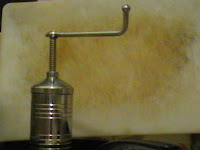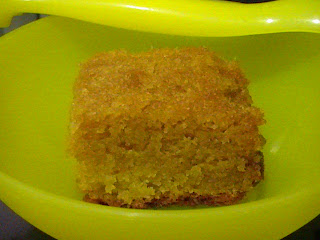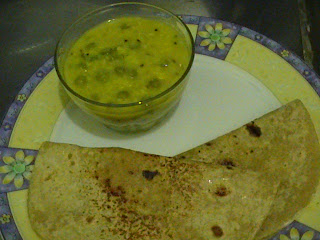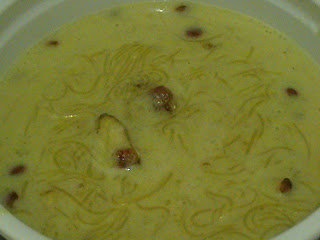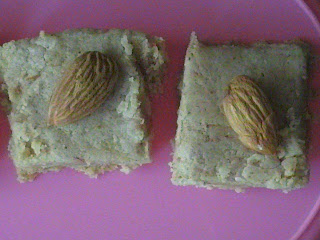What happens when you run out of time and really want to have a replete breakfast? Microwave (mw) comes to aid! Yes the above pic is of a mv'd idli. It truly didn't take much time, considering the fact that the fermented batter was atop my counter. All I did was to pull out glass bowls, grease them with coconut oil, fill two tbsp of batter...mv on high for 1 minute!! That was it and out came the (15 minutes saver) yummy idli...filling enough!
Here is the recipe for normal Idli...
Ingredients :1 cup urad daal
2 cups dosa rice
2 tbspn cooked rice
Salt to taste
Coconut oil for greasing
Method :Step I -
Washing and soaking. Wash urad daal and dosa rice seperately until clean water flows. In double the water, soak for around 5-6 hours. Preferable complete the soaking procedure for urad daal under refrigeration. (This tip is from my amma to protect the mixer jar and motor from heating up.)
Step II - Grinding. First grind the urad daal with little water into a very very fine paste, giving the mixer a standing time of a minute or two between every run. Touch to feel the silky-satin smooth batter. No grains of urad daal should be felt at this point. Run the mixie again to get a fine batter. Pour this into a vessel. In the mixer jar, take dosa rice with water visible to an inch above it. Mix it till coarse or smooth. If you are not using cooked rice, make it very smooth. If you grind the dosa rice coarsely, making it look like rava or sugar granules, please add cooked rice for fluffyness. Add the cooked rice to mixer jar, blend till it is well mixed and you get a flowing yet sauce consistency batter. Add this to the urad daal batter. Mix well with aid of a spatula or spoon till its homogenous. Leave aside covered with a lid to ferment. Choose a vessel which is large so that this batter is filled up to two third of the vessel. This batter should neither be too liquid nor too thick.
Step III - Fermenting. For places with a temperature of 25 deg C or more, the batter will ferment in 10 hours. For lower temperature areas, leave the batter to ferment for upto 24 hours or till the batter doubles up in volume. Check for fermentation. Add salt.
Step IV - Steaming and Mv Idlis. For steamer idlis : Take the idli mould...grease it with ghee or coconut oil. Place 1 1/2 tbpsn of batter into each of the four dents of a idli plate. Leave a little place..say a mm so that idli has space to rise on steaming. I use a pressure cooker. My Mil's way. So one cup of water, first goes the idli stand then the idli plates one after the other, carefully without spilling the batter out.
The stove goes on- its kept on a high flame and lid firmly placed, minus the whistle / weight.
After five minutes or just as high steam is seen from the whistle rod, lower the flame to slow and cook exactly for ten minutes. Have to keep a watch on time for this. Put it off. Give 2-3 minutes, open the lid, scoop out the idlis and serve hot with accompaniment which varies from podi, chutney, sambhar, ketchup(yes..thats for my ketchup loving kids!!) etc. Enjoy!
Ideal for a family of 5-6 members as it gives out many idlis at one go.
Time to prepare - 1 + 5 + 10 + 2 = 18 mins - 20 mins approx frm preparing the greased plates to palating it.
For microwave idlis : Six small glass bowls which are microwaveable are needed to be greased with coconut oil or ghee. 1 1/2 tbspn batter into each of the greased bowls. Place the bowls at the brim of the turntables as heat is reflected more around the corners. Microwave high for one minute and idli is ready! Take it out only after 3 minutes as center is cooked later. Depending on the settings of the mw, try one bowl first and note the time. Thereafter you may use that as standard time for mw idlis. Serve immediately.
Ideal for two people. Total time taken - 1 + 1 + 3 = 5 mins. So a real time saver for me!
 Enjoy Idlis whichever way you may please!
Enjoy Idlis whichever way you may please!

